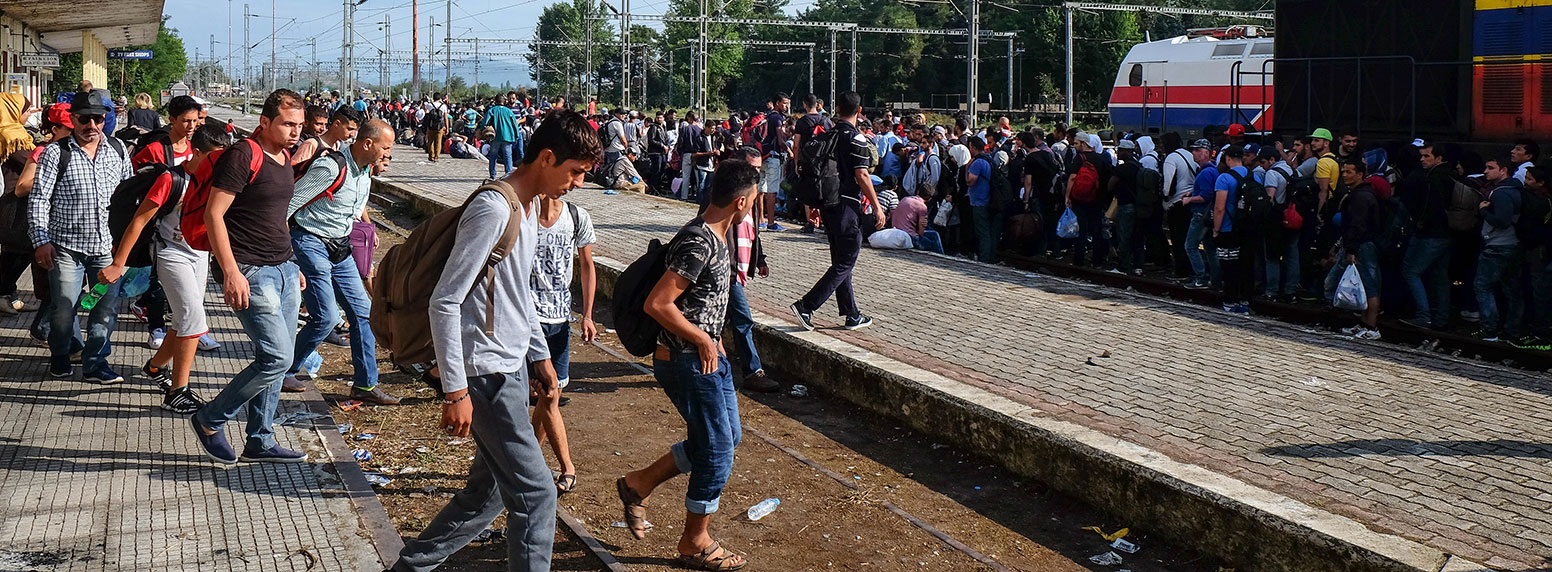by SARA PETKOVIĆ
The European Union as a unique political community has faced mass migrations of foreign populations since its inception. The greatest fear of the EU and its member states was reflected in the uncontrolled mass migration of irregular migrants. With that, the EU tried to establish a migrant policy that suits all member states, and which provides migrants with all the necessary rights and protection. However, the very complexity of the EU’s migration policy can be seen in the different responses to the two mass influxes of migrants in 2015 and 2022. As a result of such an approach, a question arises – What are the specific reasons why the EU treated refugees from Ukraine differently in 2022, as opposed to 2015, when the majority were Muslim migrants from African and Arabic countries.
In 2022, the EU decided to apply provisions of the migrant policy that had not been enforced until then. In order to respond to the mass influx of refugees from Ukraine in the best and most efficient way, the EU and its member states decided to implement the Temporary Protection Directive. This directive provides temporary protection to persons who seek refuge in EU member states from the war in their countries. The TP directive defines the decision-making procedure required to initiate, extend or end temporary protection. It also guarantees certain rights to Ukrainian refugees related to residence permits, the right to work, housing, education, and the right to adequate health care (European Commission, n.d.).
Observing the way the EU acted in 2022, the difference in the behavior and perception of EU member states such as Hungary, Poland, the Czech Republic, Germany, France or Italy was clearly different when it comes to mass migration of foreign populations. These EU countries already at the very beginning of the Ukrainian crisis decided that the most important thing is to help refugees from Ukraine and provide them with adequate protection by applying the TP directive. In this way, EU member states have shown that they can be united and unanimous when it comes to mass migration of foreign populations. The question arises whether the mass migration was percived as a threat to the survival of the collective identity of the EU, bearing in mind the behaviour of EU member states during the migrant crisis of 2015.
In order to find out the specific reasons for the different approach of the EU and its member states to mass migrations in 2022 and 2015, as well as whether mass migrations are a threat to collective identity or not, it was necessary to look back at the behaviour of the EU during the 2015 migrant crisis. Analyzing the provisions of the migrant policy that the EU implemented in 2015 regarding Muslim migrants as well as the behaviour of the member states, the EU proved to be insufficiently capable of solving the mentioned problem in a coordinated manner. EU institutions have tried through the adoption of certain provisions, such as the Migration Agenda, to force member states to show solidarity and establish control over the migrant crisis (European Commission 2015). However, the member states did not want to conform, but sought to protect themselves and their citizens from the mass settlement of people who have a different religion, race and geographical origin.
How big the problem was in 2015 can best be seen in the fact that the common asylum system of the EU together with the Dublin regulation was not enough to solve the problems caused by the mass migration of the Muslim population. The migrant crisis of 2015 showed that in the conditions of a massive influx of migrants, the Dublin system leads to a situation where practically all responsibility fell on a few EU member states (such as Italy or Greece) that could not cope with the migrant pressure on their own (Kovačević 2019). The refusal of the member states to show solidarity led to the deepening of the migrant crisis itself, and to the opposite attitudes of the EU member states when it comes to the EU’s migrant policy. What the member states have done is, when viewed through the lens of the securitization theory of the Copenhagen School of Security Studies, they have securitized a massive influx of Muslim populations (Buzan, Wæver, and de Wilde 1998).
By securitizing the mass migration of the Muslim population, EU member states such as Hungary, the Czech Republic, Poland, Italy and/or France presented the Muslim migrants to the EU public as a threat to the survival of the collective identity of the EU. In order to justify the selective implementation of the provisions of the migrant policy, the mentioned member states presented Muslim migrants as a threat to the public, highlighting their cultural differences (Chadwick 2015). In this way, a negative discourse prevailed in the EU when it comes to mass migrations of foreign populations that do not have the same or similar cultural origins as EU citizens. On the other hand, in 2022, the situation was not like that because the member states, for the sake of their personal interests, decided to approach the mass migration of Ukrainian refugees in a different way.
In 2022, with the implementation of the TP directive, the opening of their borders and the provision of all necessary rights and protection to Ukrainian refugees, a turnaround in the behaviour of EU member states was clearly seen. Now, the aforementioned countries such as Hungary, the Czech Republic, Poland, France, Germany and/or Italy perceived Ukrainian refugees in a completely different way. Ukrainian refugees were no longer a threat to the survival of the collective identity of the EU, so it was necessary to influence the discourse on mass migration among EU citizens (Nakamura 2022). From a theoretical point of view, the political officials of the EU member states avoided the speech of security and framed the mass migration of Ukrainian refugees in a humanitarian context (Entman 1993). Presenting Ukrainian refugees as a people in need for protection successfully influenced the behaviour and perception of EU citizens who now viewed Ukrainian migrants as friends in need.
Analyzing the behaviour and policy pursued by the EU in 2015 and 2022, a radical turn can be observed. In 2015, we could see a closed EU that was unable to force member states to show solidarity and respond unanimously to the consequences of the massive influx of Muslim migrants. On the other hand, in 2022 we saw an open EU whose member states unanimously decided to implement the TP directive in order to provide Ukrainian refugees with all the necessary assistance and protection. Based on the theory of securitization, the theory of framing and social security, I concluded that the concrete reasons why the EU behaved differently with its countries in 2022 are reflected in geopolitical interests and cultural factors.
The EU and its member states treated Ukrainian refugees differently in 2022 due to the solidarity of the EU and its member states with Ukraine due to the conflict with the Russian Federation, which is treated as a major geopolitical rival of the EU. Accordingly, the reasons for the better treatment of Ukrainian refugees lie in the fact that the EU and its member states did not approach the securitization of their mass migration as in 2015, but humanitarian framing. By applying the humanitarian framing of the mass migration of the Ukrainian population, the EU did not present the Ukrainian people as a threat to the survival of the collective identity of EU citizens. On the other hand, the behaviour of the EU towards refugees from Ukraine was conditioned by their cultural similarities. This mostly related to the fact that in addition to being Europeans with whom they share a similar culture and language, they are also white-skinned Christians, unlike the Arab or African migrants who were both from another continent and dark-skinned Muslims.
The question arises whether migration is a threat to the collective identity of the EU or not. Viewed through the prism of societal security theory, it could be said that the claims of Buzan, Wæver and De Wilde are justified and that migration is a real threat to the security of the collective identity of the EU (Ejdus 2017). Although in 2022 they influenced the negative discourse on migration among EU citizens, the member states did not approach the desecuritization of the mass migration of people with a different cultural origin. Muslim migrants will continue to be seen as a threat in the future, because otherwise the EU would apply the provisions of the TP directive to still arriving Muslim migrants, not only to refugees coming from Ukraine. The main reasons why the EU in 2022 did not apply the securitization discourse when it comes to Ukrainian refugees are reflected in cultural similarities, solidarity, but also in the geopolitical interests of the EU.
To conclude – the specific reasons for the EU’s different approach to mass migration in 2015 and 2022 lie in its geopolitical interests and cultural similarities. We can only ask how such a radical turn in the implementation of the provisions of the migrant policy will affect the EU and its member states, bearing in mind that the implementation of the TP directive only masked the crisis that the EU’s migrant policy fell into in 2015. This raises a number of questions that need to be answered, such as how important the gender element of migrants is, whether this implementation of different provisions of the migrant policy deepens disagreements between member states, as well as how the implementation of the TP directive will be reflected in the future not only on the EU, but also on all its citizens.
Bibliography
Buzan, Barry, Ole Wæver, and Jaap De Wilde. 1998. Security: A new framework for analysis. London: Lynne Rienner Publishers.
Chadwick, Vince. 2015. “The top 10 wackiest anti-refugee remarks.” Politico, October 19. https://www.politico.eu/article/toxic-news-refugees-migrants-eu/.
Ejdus, Filip. 2017. Međunarodna bezbednost: Teorije, sektori i nivoi. Beograd: Fakultet političkih nauka.
Entman, Robert M. 1993. “Framing: Toward clarification of a fractured paradigm.” Journal of Communication 43 (4): 51–58.
European Commission. n. d. “Temporary protection.” European Commission, https://home-affairs.ec.europa.eu/policies/migration-and-asylum/common-european-asylum-system/temporary-protection_en.
European Commission. 2015. “The European agenda on migration.” European Commission, May 13. https://ec.europa.eu/migrant-integration/news/european-commission-european-agenda-migration_en?lang=de.
Kovačević, Maja. 2019. “Evropski parlament i reforma zajedničkog evropskog sistema azila.” Godišnjak FPN 13: 149–165.
Nakamura, Kate. 2022. “41 Inspiring Quotes From World Leaders Showing Their Support for Stand Up for Ukraine.” Global Citizen, April 9. https://www.globalcitizen.org/en/content/world-leader-quotes-stand-up-for-ukraine/.
This paper was created during the research for writing the master’s thesis “Policy of the European Union towards migrants in 2015 and 2022”, which was defended at the University of Belgrade, Faculty of Political Sciences in September 2023.
Sara Petković graduated and mastered at the Department of International Studies at the Faculty of Political Sciences of the University of Belgrade. The topic of her master’s thesis was related to the policy that the European Union and its member states implemented during two mass influxes of migrants in 2015 and 2022. Her main interests are related to the functioning of the EU political system, EU foreign policy and its role as a global actor.
Photo credit: 2019.democrats.eu







